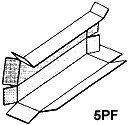Note

This blog is proudly prepared and presented by:
*Wong Qian Hui (P02)
*Ng Kim Leong (P04)
*Chew Meng Wei (P05)
*Seah Yan Lin (P05)
*Tan Mei Jia Bella (P05)
*Ye Shuying (P05)
Data
{Sunday, January 14, 2007 @ 8:54 PM}
How to measure Corrugated boxes

Box DimensionsBox dimensions are always Inside dimensions and must be stated in the sequence of length, width and depth. Even when the box is to have interior packing, the dimensions given should be the inside dimensions of the box irrespective of the interior packing. The length is the larger of the two dimensions of the open face (flap opening); the width is the smaller. The depth is always the distance measured perpendicular to the length and the width between the innermost surfaces of the box.
Even so-called "end o-opening" or "end-loading" boxes follow the above principles. Thus, the depth is still the dimensions between the innermost surfaces of the box measured perpendicular to the length and width.
A tight fit is important for safe transportation and the box manufacturer is better able to design a box of the proper size if he is furnished with a sample of the article to be packed. If it is not practicable to submit a sample, a complete description of the article, including drawings when available, the quantity to be packed, and the weight to be shipped in the box should be supplied to insure that the box which is designed will comply with the carriers specifications. 


To properly measure a corrugated box, score to score measurements should be taken for each dimension. Since, when describing a corrugated box the inside dimensions (or usable carton capacity) is considered, predetermined deduction from score to score measurements must be made to arrive at the true box size. Board flute, being of variable thickness, requires that each flute have there own set of score to score measurement deductions, as follows:
 This blog is proudly prepared and presented by:
*Wong Qian Hui (P02)
This blog is proudly prepared and presented by:
*Wong Qian Hui (P02)
 This blog is proudly prepared and presented by:
*Wong Qian Hui (P02)
This blog is proudly prepared and presented by:
*Wong Qian Hui (P02)

